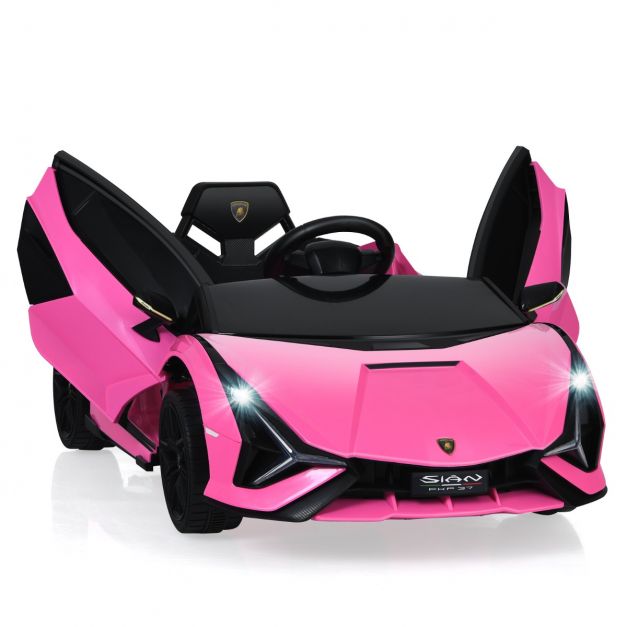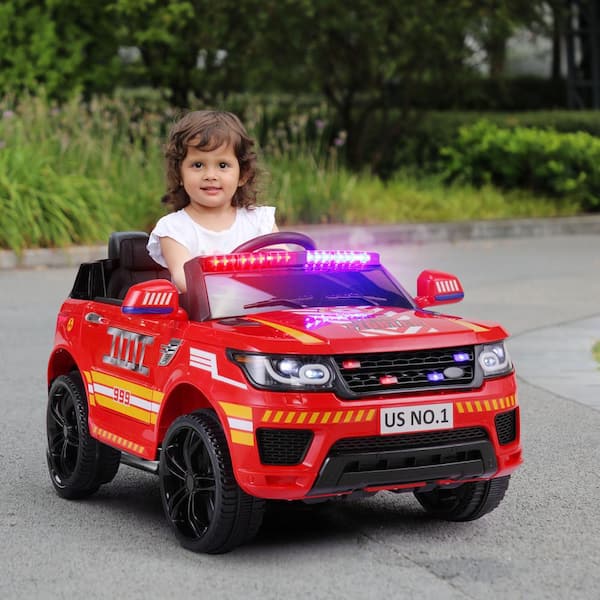Understanding the battery time and life of a kid's electric car is crucial to make sure your child enjoys an enjoyable and safe ride. Here's all you need be aware of about the battery type.
Most electric ride-on vehicles are rechargeable and use either lithium-ion or lead-acid batteries. In general, rechargeable lithium-ion batteries offer a longer battery life as well as quicker charging times than lead acid ones.
Capacity of Battery
The capacity of a battery can be measured in either amps-hours or watts. Larger capacity batteries provide more playtime between recharges.
Run Time -
The duration of the runtime for an electric vehicle is the amount of time it can run continuously on a single battery charge. The running time of an electric ride-on vehicle will vary depending on the factors like battery capacity and motor power. It is also dependent on the terrain as well as the user's weight.
The average run time of electric ride-ons is between 30 to 2 hours. However, some high-capacity batteries may offer longer run times.
Time to charge -
The charging time is the amount of it takes to fully recharge a depleted battery. Charging times can vary depending on the battery capacity, charger specs and charging method.
Charge times vary between 8 and 12 hours to full charge of electric ride-on cars. Some models provide faster charging times, particularly when using lithium-ion batteries.
Follow the instructions for charging given by the manufacturer to ensure the safety of your battery and its long-term durability. The battery's performance and its lifespan could be affected negatively by either overcharging it or undercharging it.
Charge Methods -
Chargers for electric ride-ons are usually connected to standard electrical outlets. Certain models allow quick charging, or have an intelligent charger that monitors and regulates the rate at which the battery is charged.
Check that the connectors and charging ports on ride-on car are compatible, so that there is no damage to either the battery or electrical components.
Additional Batteries -
Some electric ride-on vehicles provide the option of purchasing additional batteries or spare batteries to allow for extended playing time. Batteries that are extra allow you to replace depleted batteries by fully charged batteries which minimizes downtime.
Knowing the battery's charge time of a ride-on kid's car will help ensure that both you and your child enjoy uninterrupted, fun time and exciting adventures. Using the correct charging techniques and charging the battery regularly will prolong battery life. Take a look at the most popular JCB ride on toys for blog tips including car for toy, car for toy, digger ride, kiddies cars, ride of car, childs electric ride on car, toy car for car, lambo toy car, toy and car, childs electric ride on car and more. .

What Is The Assembly And Maintenance Conditions For Children's Ride-On Vehicles?
Kids' ride-on cars usually require some assembly and regular maintenance to ensure their performance is optimal as well as safety and longevity. These are the most frequently-used assembly and care requirements for children's ride-on car.
Most ride-on vehicles arrive partially assembled and require assembly. It usually involves attaching parts such as wheels and steering wheel, seats, and other components according to the instructions of the manufacturer.
Install the components in accordance with the directions. To complete the assembly, you will need the tools and accessories that are provided.
Cleaning –
The ride-on vehicles should be maintained regularly to ensure that they appear good and perform effectively. Clean up the exterior surfaces using an abrasive sponge or cloth that has been soaked in mild soapy water. This removes dirt, dust and other particles.
Be particularly attentive to areas susceptible to buildup such as tires, undercarriage, and wheels. Use a brush and toothbrush to clean those difficult-to-access areas.
Avoid harsh chemicals or cleaners that are abrasive, since they can damage paintwork or electronic components.
Battery Care –
If the ride-on car is powered with a rechargeable battery proper battery care is essential to maintain performance and prolong the life of the battery. Follow these guidelines for battery care -
It is essential to charge your battery fully prior to and after each use to get the most from it.
Avoid overcharging your battery or leaving it hooked up to chargers for an prolonged period of time. Both can damage it and shorten its lifespan.
When not in use when not in use, store the ride on car and battery away from direct sunlight or extreme temperatures.
The battery terminals should be inspected periodically for damage and corrosion. They can also be cleaned with wire bristles or terminal cleaner, should it be required.
If the battery stops charging or has signs of damage, replace it.
Tire Maintenance -
Always check the tires for indications of wear, damage or loss of air. If necessary, you can make use of a bicycle air pump or air compressor to fill the tires at the recommended pressure.
Examine the tread pattern to determine if there are any foreign objects or other debris which could lead to flats or punctures. Replace or repair damaged tires, if needed. Remove obstructions.
Lubricate your wheel bearings and axles to ensure smooth movement.
Occasional repairs or replacements
Wear and tear or damage from accidents can cause parts of ride-on cars to need replacement or repair.
Watch out for indicators of wear or damage for unusual sounds, loss of power, or an unpredictable behavior. Refer to the manufacturer's specifications or contact customer support for guidance on troubleshooting and repair solutions.
Replace damaged or worn-out components promptly to stop further damage and to ensure the safety and functionality of the ride-on automobile.
If you follow these guidelines for maintenance and assembly You can ensure that your child's car in top condition and enjoy hours of fun and safe playing time for your child. Check out the top rated go here about Mercedes ride on car for website recommendations including toy car, kiddies cars, childrens electric ride on, car electric ride on, toy ride, childs electric ride on car, remote control childrens car, ride electric car, race car toy car, toy car toy car and more. .

What Is The Best Remote Control Car For Children? What Are Their Advantages And Disadvantages?
Remote control cars for kids are also referred to remote controlled vehicles or RCs. They come in a wide variety of styles, price points, and sizes to suit every budget and preference. Here's a rundown of the pros and cons, and the sizes of remote controlled cars.
Electric RC Cars – Battery-powered remote-controlled cars that are suitable for indoor or outdoor use. They come in various styles, including trucks, buggies, and sports cars.
Nitro RC Cars – Gas RC vehicles with higher speed and higher performance. However, they require more expertise and maintenance to operate. These cars are usually larger and cost more than electric RC vehicles.
Scale Models (Remote-controlled replicas) They are miniatures of real-life automobiles like airplanes, trucks or automobiles. Scale models come in different sizes, from 1 10 to 1-24 and larger scales providing more details and authenticity.
Sizes -
The dimensions of remote-controlled cars for children range from tiny micro-sized versions to larger-scale replicas. The size and weight of the car can affect the performance.
Micro-sized cars are small and lightweight, making them perfect for indoor play and use by younger children. The larger cars have more power and are durable and are perfect for racing outdoors and off-road driving.
Prices
The price of a remote-controlled car for children is dependent on the dimensions, features, manufacturer, and build-quality.
The Nitro and Electric RC cars on a larger scale may cost anywhere from $100 to $500.
Scale models, high-end hobby RCs can cost anywhere from several hundred bucks to over a $1,000 depending on the detail level and performance.
Pros and Cons
Pros -
Adults and children will have hours of fun and entertainment with remote control cars.
Skills Development. Operating a RC car lets children develop hand-eye coordination as well as spatial awareness and problem-solving capabilities.
Social interaction. You can enjoy RC vehicles with your loved ones and family and encourages social interaction.
Customization - Many RC automobiles can be modified by utilizing aftermarket parts, upgrades and accessories to enhance the performance and look.
Cons
Cost - A remote-controlled vehicle for children that has advanced features or even hobby model cars can cost a lot.
Learning Curve - Operating an RC car requires a lot of practice and skills, and young youngsters may have difficulty with the controls in the beginning.
Maintenance - Cars with RC engines require regular maintenance, which includes cleaning, lubrication, as well as periodic repairs or replacement of parts.
Safety Issues - RC car safety can be affected by collisions, electrical hazards and other hazards if the cars are not used with caution and supervision by an adult.
Overall, remote controlled children's vehicles provide a thrilling as well as educational experience for kids of all ages, but it's essential to consider factors such as size, price features, and safety when selecting the best car for your child. For older kids, hobby grade RC cars may be a better option. However, more basic models can also be an ideal choice for children who are younger. Read the most popular remote control childrens cars kidscars.co.uk recommendations for blog recommendations including car toy car toy, toy cars toy car, toy the car, ride electric car, ride on car, car electric ride on, electric ride on cars, ride of car, car toy car toy, riding digger and more. .
